Shoulder Surgery
These articles are for general information only and are not medical advice. Full Disclaimer. All articles are compliments of the AAOS
Rotator Cuff, Impingement
Your shoulder is the most flexible joint in your body. It allows you to place and rotate your arm in many positions in front, above, to the side, and behind your body. This flexibility also makes your shoulder susceptible to instability and injury. This brochure will help you understand how your shoulder works and the common causes of shoulder problems, the available treatment options, and exercises and activities to enable you to regain pain-free use of your shoulder.
Depending on the nature of the problem, conservative nonoperative methods of treatment often are recommended before surgery. However, in some instances, delaying the surgical repair of a shoulder can increase the likelihood that the problem will be more difficult to treat later. Early, correct diagnosis and treatment of shoulder problems can make a significant difference in the long run.
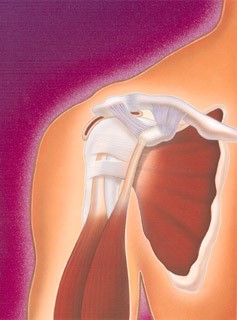
How the Normal Shoulder Works
The shoulder is a ball-and-socket joint. It is made up of three bones: the upper arm bone (humerus), the shoulder blade (scapula), and the collarbone (clavicle).
The ball at the top end of the arm bone fits into the small socket (glenoid) of the shoulder blade to form the shoulder joint (glenohumeral joint). The socket of the glenoid is surrounded by a soft-tissue rim (labrum). A smooth, durable surface (articular cartilage) on the head of the arm bone, and a thin inner lining (synovium) of the joint allow the smooth motion of the shoulder joint.
The joint capsule is a thin sheet of fibers that surrounds the shoulder joint. The capsule allows a wide range of motion yet provides stability. A rotator cuff is a group of muscles and tendons that attach your upper arm to your shoulder blade. The rotator cuff covers the shoulder joint and joint capsule. The muscles attached to the rotator cuff enable you to lift your arm, reach overhead, and take part in activities such as throwing or swimming.
A sac-like membrane (bursa) between the rotator cuff and the shoulder blade cushions and helps lubricate the motion between these two structures.
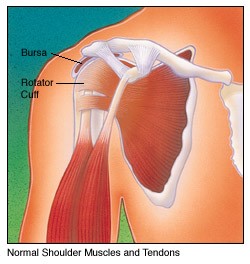
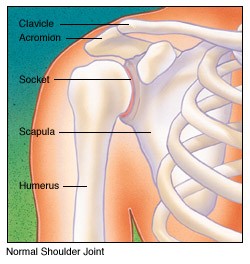
Shoulder Problems and Treatments
Bursitis or Tendinitis can occur with overuse from repetitive activities such as swimming, painting, or weight lifting. These activities cause rubbing or squeezing (impingement) of the rotator cuff under the acromion and in the acromioclavicular joint. Initially, these problems are treated by modifying the activity which causes the symptoms of pain and with a rehabilitation program for the shoulder.
Impingement and Partial Rotator Cuff Tears Partial thickness rotator cuff tears can be associated with chronic inflammation and the development of spurs on the underside of the acromion or the AC joint. The conservative nonoperative treatment is a modification of activity, light exercise, and occasionally, a cortisone injection. Nonoperative treatment is successful in a majority of cases, but if it is not successful, surgery often is needed to remove the spurs on the underside of the acromion and to repair the rotator cuff.
Full Thickness Rotator Cuff Tears are most often the result of impingement, partial thickness rotator cuff tears, heavy lifting, or falls. Nonoperative treatment with modification of activity is successful in a majority of cases. If you continue to have pain, surgery may be needed. Surgery may be necessary to repair full-thickness rotator cuff tears. Arthroscopic techniques allow the shaving of spurs, evaluation of the rotator cuff, and repair of some tears. Both techniques require extensive rehabilitation to restore the function of the shoulder.
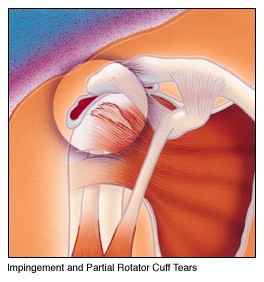
Instability occurs when the head of the upper arm bone is forced out of the shoulder socket. This can happen as a result of sudden injury or from overuse of the shoulder ligaments.
The two basic forms of shoulder instability are subluxations and dislocations. A subluxation is a partial or incomplete dislocation. If your shoulder is partially out of the shoulder socket, it eventually may dislocate. Even a minor injury may push the arm bone out of its socket. A dislocation is when the head of the arm bone slips out of the shoulder socket. Some patients have chronic instability, shoulder dislocations occur repeatedly.
Patients with repeat dislocation usually require surgery. Open surgical repair may require a short stay in the hospital. Arthroscopic surgical repair is often done on an outpatient basis. Following either procedure, extensive rehabilitation, often including physical therapy, is necessary for healing.

Fractured Collarbone and AC Joint Separation are common injuries of children and others who fall on the side of their shoulder when playing. Most of these injuries are treated nonoperatively with slings or splints. Severely displaced fractures or AC joint separation may require surgical repair.
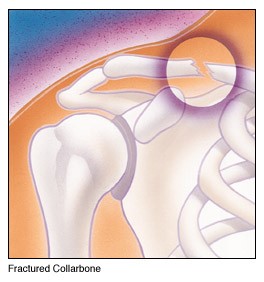
A Fractured Head of the Arm Bone is a common result of falls on an outstretched arm, particularly by older people with osteoporosis. If fragmented or displaced, it may require open surgical repair and possibly replacement with an artificial joint (prosthesis).
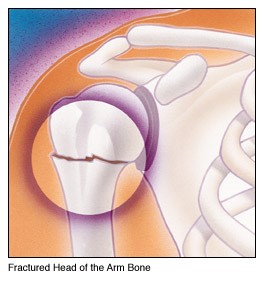
Osteoarthritis and Rheumatoid Arthritis can cause destruction of the shoulder joint and surrounding tissue, as well as degeneration and tearing of the capsule or the rotator cuff. Osteoarthritis occurs when the articular surface of the joint wears thin. Rheumatoid arthritis is associated with chronic inflammation of the synovium lining which can produce chemicals that eventually destroy the inner lining of the joint, including the articular surface.
Shoulder replacement is recommended for patients with painful shoulders and limited motion. The treatment options are either replacement of the head of the bone or replacement of the entire socket. Your orthopedic surgeon will discuss with you the best option.
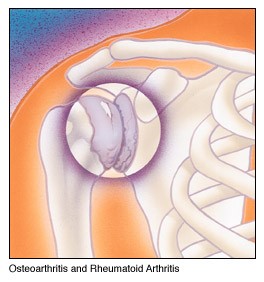
Orthopedic Evaluation
The orthopedic evaluation of your shoulder consists of three components:
- A medical history to gather information about current complaints; duration of symptoms, pain, and limitations; injuries; and past treatment with medications or surgery.
- A physical examination to assess swelling, tenderness, range of motion, strength or weakness, instability, and/or deformity of the shoulder.
- Diagnostic tests such as X-rays taken with the shoulder in various positions. An MRI (Magnetic Resonance Imaging) may be helpful in assessing soft tissues in the shoulder. A CT (Computerized Tomography) scan may be used to evaluate the bony parts of your shoulder.
Your orthopedic surgeon will review the results of your evaluation with you and discuss the best treatment. You and your doctor may agree that surgery is the best treatment option. He or she will explain the potential risks and complications that may occur. Your doctor may discuss donating your own blood to be used if needed during surgery.
Some surgical procedures require you to be hospitalized for several days. Your doctor may discuss planning for the period after surgery. You may need to either stay in an extended care facility or have someone help you when you return home.

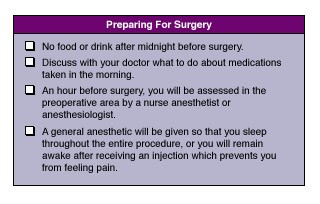
Types of Surgical Procedures
You may be given the option to have an arthroscopic procedure or an open surgical procedure.
Arthroscopy allows the orthopedic surgeon to insert a pencil-thin device with a small lens and lighting system into tiny incisions to look inside the joint. The images inside the joint are relayed to a TV monitor, allowing the doctor to make a diagnosis. Other surgical instruments can be inserted to make repairs, based on what is with the arthroscope. Arthroscopy often can be done on an outpatient basis.
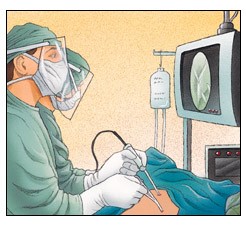
Open surgery may be necessary and, in some cases, associated with better results than arthroscopy; open surgery often can be done through small incisions of just a few inches.
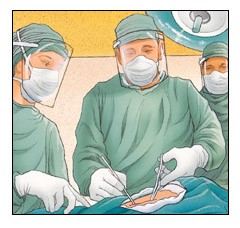
Recovery and rehabilitation are related to the type of surgery performed inside the shoulder, rather than whether there was an arthroscopic or open surgical procedure.
Possible Complications After Surgery
There are always some risks with any surgery, even arthroscopic procedures. These include possible infection and damage to surrounding nerves and blood vessels. However, modern surgical techniques and close monitoring have significantly minimized the occurrence of these problems.
After surgery, some pain, tenderness, and stiffness are normal. You should be alert for certain signs and symptoms that may suggest the development of complications.
Be sure to call your doctor if you develop any of these symptoms after surgery.
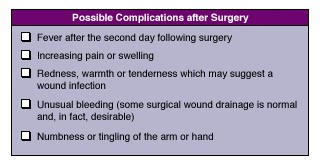
Prevention of Future Problems
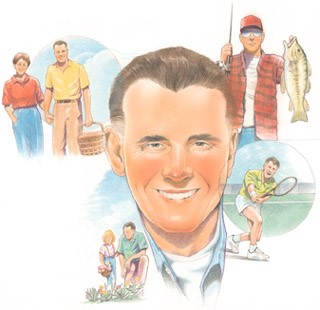
It’s important that you continue a shoulder exercise program with daily stretching and strengthening. In general, patients who faithfully comply with the therapies and exercises prescribed by their orthopedic surgeon and physical therapist will have the best medical outcome after surgery.
Your orthopedic surgeon is a medical doctor with extensive training in the diagnosis and nonsurgical and surgical treatment of the musculoskeletal system, including bones, joints, ligaments, tendons, muscles, and nerves.
This brochure has been prepared by the American Academy of Orthopedic Surgeons and is intended to contain current information on the subject from recognized authorities. However, it does not represent the official policy of the Academy and its text should not be construed as excluding other acceptable viewpoints. Persons with questions about a medical condition should consult a physician who is informed about the condition and the various modes of treatment available.
